
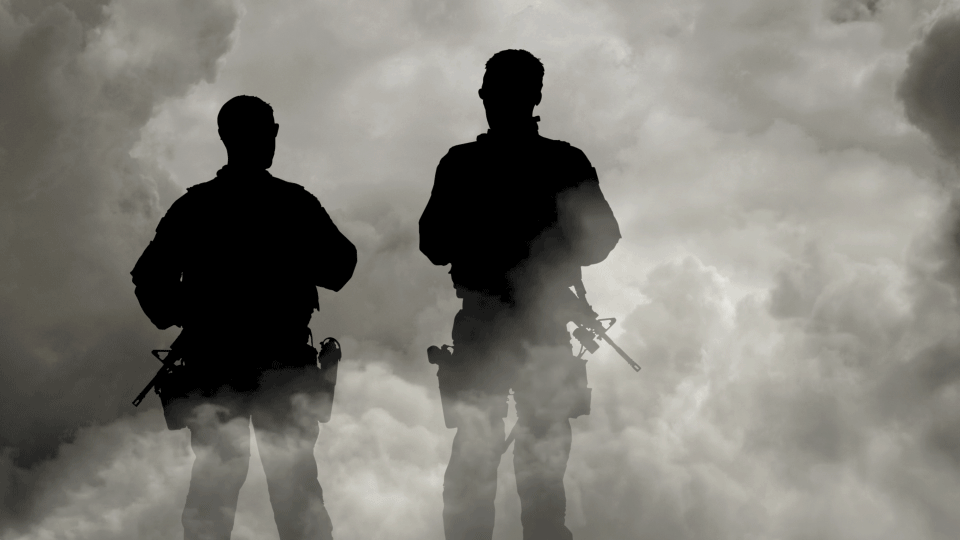

Can you feel the strain? The Army wants more troops. The Air Force wants more money and newer planes. The Navy wants more ships and is battling over what to do with the fleet it has. And the Marines — well the Corps isn’t sure what comes next, but they’re staying in the fight.
Spend big, fight small. Be ready to roll everywhere, but stay out of a big war anywhere. Destroy the Islamic State, check down Russia and China, prepare for nuclear war, buy long-range bombers, defend cyber networks and satellites, patrol the seas, and expand covert special ops missions to capture and kill Islamic State leaders. And while you’re at it, modernize the workforce, open up to women, honor commitments to families, and do a better job connecting with the American public.
The state of defense, from top to bottom, is everywhere. It’s a time of changes, to the force and its mission. But there is clear priority at the Pentagon: the war against ISIS.
In December, Defense Secretary Ash Carter told Congress the military already had made nine changes to “accelerate” the counter-ISIS fight in response to President Barack Obama’s order. Already, there are some signs of success, from retaking Ramadi to killing scores of high-value targets with drone strikes. But Obama refused to strike early and now ISIS’s influence has outgrown its territory. Carter warned Congress that he’d be asking for more ways to defeat ISIS in the months ahead, including boosting international support, and 2016 should prove pivotal. It could see more ground successes, if U.S.-backed coalition forces retake Mosul and the rest of Iraq’s major cities, and move Syria (and Russia) toward a peace process, while increased special operations raids continue to decimate and pressure ISIS leaders. But without an ideological defeat of ISIS, the group’s influence — now inspiring individual attacks in Chattanooga, San Bernardino, and Philadelphia — the fight will continue far into the future. In January, the administration announced it was revamping its fledgling counter-propaganda campaign. That should be welcome news to military leaders who continue to be the first to remind Washington — and the American public — there is “no military solution” to the problem of ISIS.


ISIL fighters wave the group's flag from a damaged display of a government fighter jet following the battle for the Tabqa air base, in Raqqa, Syria. (AP Photo/Raqqa Media Center of the Islamic State group)
Beyond that, in this last year of the Obama administration, Defense Secretary Ash Carter and Deputy Defense Secretary Bob Work will try to solidify their efforts to keep America’s technological edge over its adversaries and field the most diverse and ready force yet. It’s the “offset strategy,” or as Work describes it, “a significant and hopefully enduring effort to extend our military, technological and operational edge well into the future.” The Pentagon is worried that rivals are developing their capabilities faster than the U.S. is rolling out new ones. The edge is shrinking, they argue. So expect to see Carter continue on his tech-heavy personal mission.
There are many new minds ready to lead their services into the new era — a new Joint Chiefs chairman and new chiefs of the Marine Corps, Navy, and Army, and a new Army secretary — all with new plans, budgets, and priorities. They know there is little public appetite for major bumps in defense spending, yet they they want more: more troops, more money, more equipment, more training. And they have some creative ideas about how to get it, with a “Force of the Future” plan to open side doors to military service, mid-career breaks, and modernized benefits.
Why? The fight is not ending. In the Middle East, Obama and his war cabinet promised increased special operations raids, air strikes, and intelligence operations. Those will require the full support of the conventional armed forces, frequently forward deployed, and always at the ready. In Afghanistan, Obama already halted his drawdown plans and now Gen. John Campbell may ask for additional troops as the Taliban has roared back into regions thousands of Americans already died to reclaim, and as Kabul is under a siege of bombings. In Asia, the pivot continues as China’s new islands expand it’s borders and North Korea remains a nuclear threat.
Meanwhile, the president still hopes to close the prison at Guantanamo.
Oh, and it’s the 2016 presidential campaign year. There is not much nuance from most candidates, who offer plenty of fear and excitement. “The world is on fire,” said Florida Sen. Marco Rubio, in January. “Where’s America?” Just ask anyone in the “finest fighting force the world has ever known” and they already know the answer: everywhere.
***
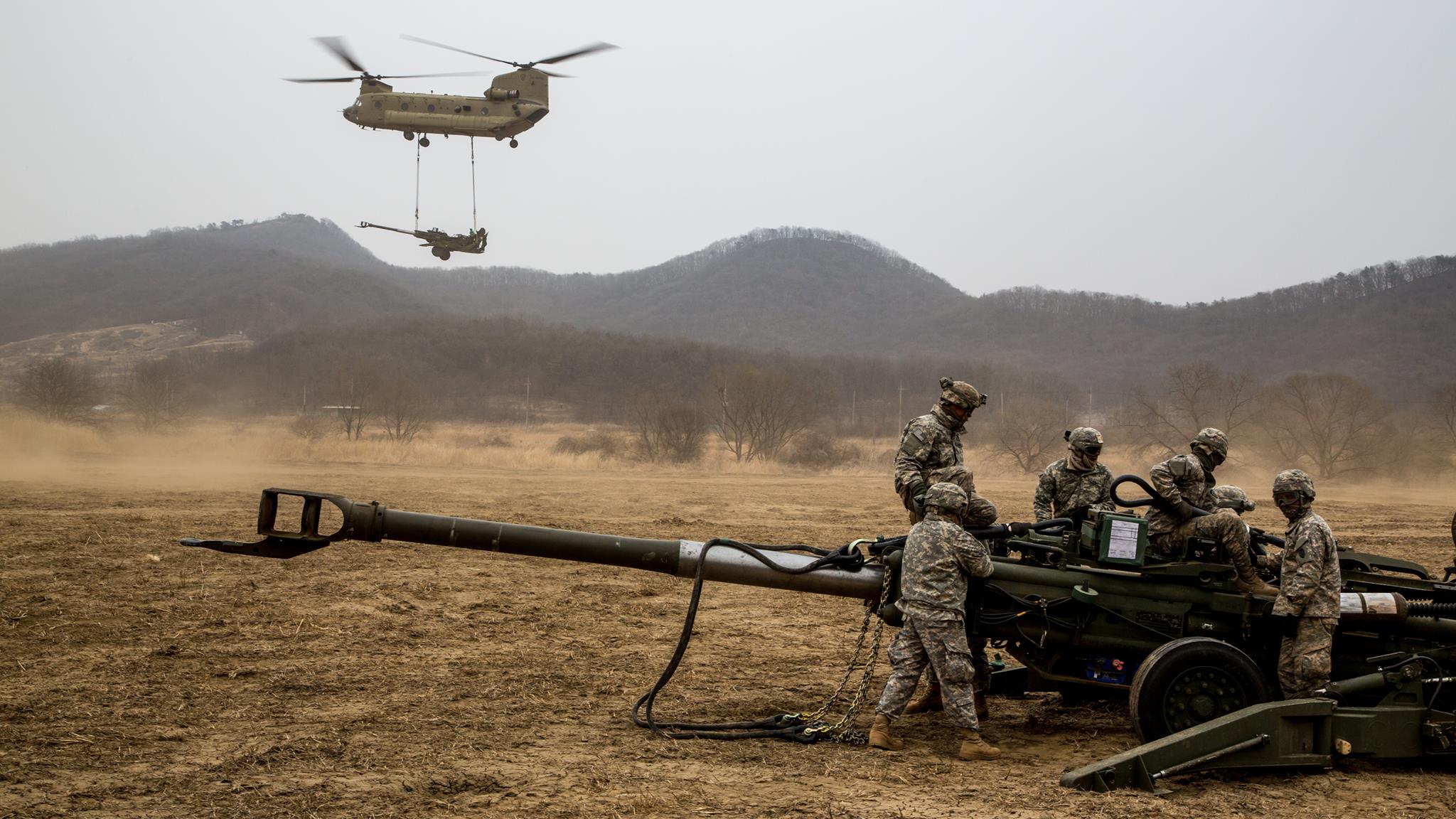

Four years into a penny-pinching strategy that predates ISIS and Russia’s ‘little green men,’ many soldiers are feeling the strain.
For four years and counting, the U.S. Army has been reducing its global footprint and its overall troop numbers. For almost that long, senior leaders have been warning that this path will eventually turn America’s ground combat force into a paper tiger.
The Army has some 490,000 active duty troops in its ranks today, down from its 2011 peak of more than 560,000. Another 15,000 are to be cut by October, while the Guard and Reserve will shed about the same.
More to the point, perhaps, is the reduction in brigade combat teams — the 4,500-person units that are the main building block of the Army’s striking force — from 45 at the beginning of President Barack Obama’s second term to 32 today. Yet only about one-third of the teams are available for action, Army chief Gen. Ray Odierno told lawmakers before he stepped down last year. That’s largely because budget crunches have hindered the overall training regimen — what military officials like to call “readiness.” In February, Army budget officials warned repeatedly that a BCT that missed some key elements of training could require up to 30 months to recover. And with the duration of combat training rotations having increased by more than 20 percent in 2015, that budgetary formula looks even more problematic for 2016 and beyond.
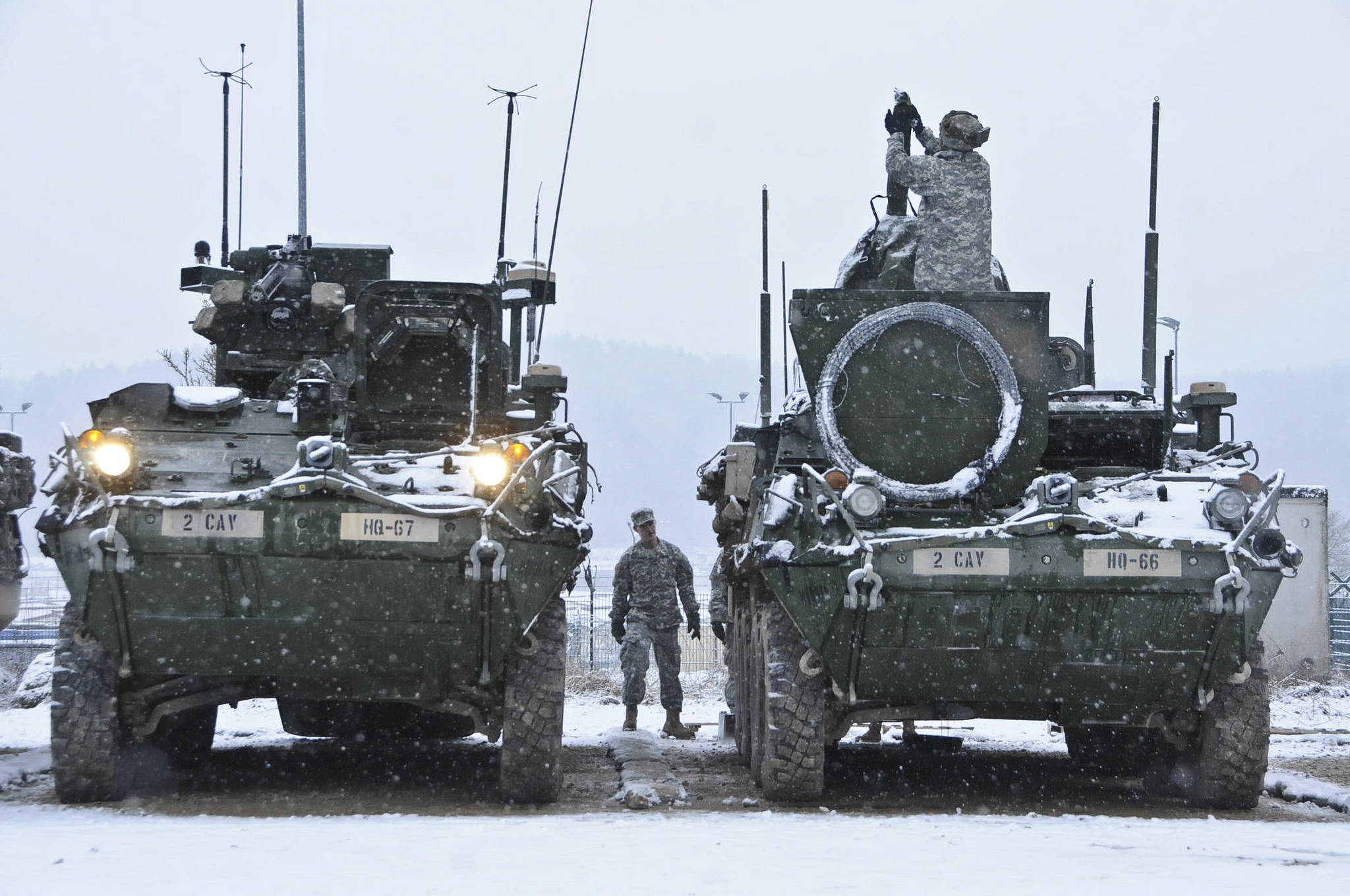
Where are the soldiers?
-
27,000 troops in Europe.
-
Nearly 50,000 across East Asia and the Pacific, mostly in Korea.
-
Almost 1,700 celebrated the New Year in Africa.
-
And 20,000 are in Afghanistan and the Middle East.
Dragoon troopers perform preventive maintenance and services to their equipment while constructing a Regimental Tactical Operations Center during Allied Spirit I, Hohenfels, Germany, Jan. 20, 2015. (US Army Photo)
Things are only getting more complicated. With Russia now atop the U.S. military’s threat list, it’s not just about counterinsurgency for the Army, but full-spectrum warfare—everything from surveillance to cyber, mundane base security to infantry training in the Baltics—which all adds up to longer periods before units can be confidently declared “combat-ready,” should they be called into action.
Ultimately, how many troops are enough? Attempting to answer the question begins to make America resemble the fatally ambitious farmer in Tolstoy’s “How Much Land Does a Man Need?” It’s the short tale of a peasant whose lust for more land leads to exhaustion and death one dark night in the Russian countryside. The U.S. can’t possibly put out every fire that breaks out across the globe, though Army leaders often speak as though they are preparing for the call. Obama, however, has proven very reluctant to send more troops anywhere. The year’s highest-profile bump, the 3,500 U.S. troops now in Iraq, are largely special operations forces, or SOF. Even with Russia widening its military presence from Ukraine and down into Syria, the fiscal year that ended in September saw a net decline in U.S. soldiers in Europe, although some more Bradleys and Howitzers were set to head back in succeeding months.
More than anything, the U.S. Army of 2016 is a training and advisory force, focused on prepping Washington’s allies to fight a variety of threats on the ground and elsewhere. Even as the service was trying like hell to project a force ready to battle Russia’s hybrid tactics, it was helping to organize a similar, and even larger NATO exercise this fall across Spain, Portugal and Italy. And yet the Army (and its sister services) spent years trying to improve government forces in Iraq and Afghanistan, only to learn that the U.S. is not particularly good at that mission. (See, for example, this Congressional Research Service report on the depressing lessons from efforts to “build partner capacity.”)
Don’t expect this to change during an election year. Obama’s Army is largely a combat-averse force held close like an ace up the White House's sleeve. It’s just that everyone sees it and no one believes the president will play it. The truth is, as Obama explained in December, thousands of caskets returning home from America’s wars have discouraged the commander-in-chief from traditional military escalation abroad, especially large ground invasions that in many ways are the Army’s bread and butter.
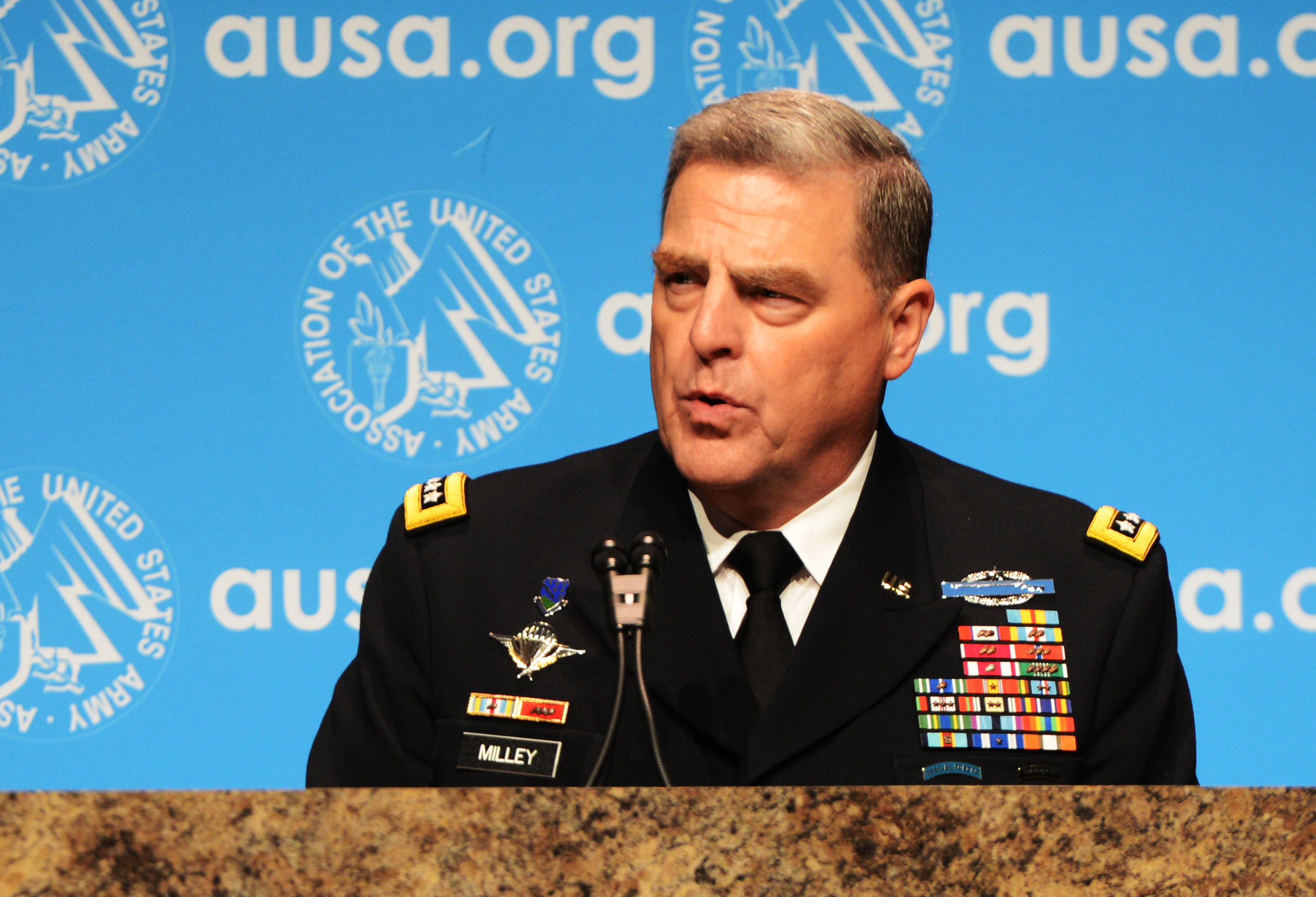
Army Chief of Staff Gen. Mark A. Milley serves as keynote speaker at the Dwight David Eisenhower Luncheon during the annual meeting of the Association of the United States Army, Oct. 13, 2015. (Photo by David Vergun)
Still, the Army’s new chief, Gen. Mark Milley, has little choice but to keep his dwindling troops as ready for ground combat as training and dollars will allow. “Readiness for ground combat is—and will remain—the U.S. Army’s #1 priority. We will always be ready to fight today, and we will always prepare to fight tomorrow,” he said in his first message to troops in August.
But do the Army’s seasoned soldiers really want to be in combat? Every soldier Defense One spoke to said they would jump at the chance to kill ISIS fighters, of course, but not a one wants to stay around for what happens next. They’ve seen that movie twice already. Each said they know well what they signed up for; but they’re tired from years of bruising pre- and post-deployment routines. Senior enlisted and officers alike describe a service still licking its wounds from more than a decade of bloody, urban combat. On top of this is the continuing strain on home and family life that has come with repeated deployments. And while the deployments of the last few years are not back-to-back, as they were at the height of the Iraq war, the more recent trips to “the sandbox” have nonetheless taken a toll on troops’ personal happiness and well-being. (Indeed, the Army spent $287 million to study troops’ penchant for optimism only to find out that most were anything but happy.)
Many soldiers expect 2016 to look a lot like 2015.
With Defense Secretary Ash Carter’s decision to open combat roles to women, at least one segment of the Army has cause for celebration in 2016. But with the Army’s integration plan having been submitted to Carter only recently, it’s anyone’s guess when or how the new changes will take effect. The November elections, of course, will usher in a new commander in chief, and perhaps a new direction for the Army—which will implement a new NCO evaluation system this year to curb “promotion inflation.” In the meantime, with no real victories to declare from more than a decade of war, many soldiers expect 2016 to look a lot like 2015—only with new uniforms free of all the pixelated, green urban-warfare camo that troops loved to hate.
***
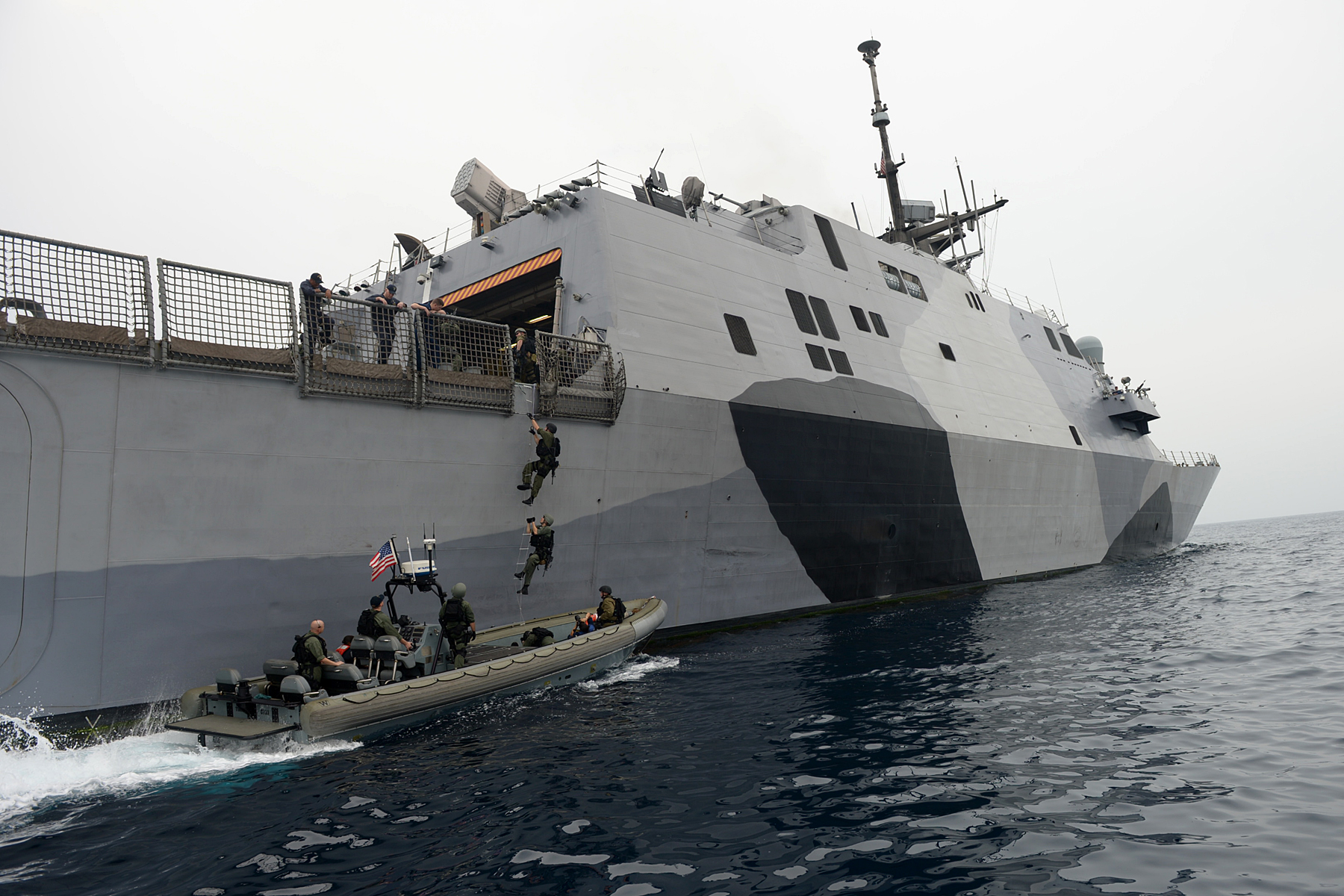

Laying in a course change to meet a newly belligerent Russia and still-rising China.
Ask Ray Mabus about the tenets of naval power, and the first word out of the Navy secretary’s mouth is “presence.” As in: that unique ability of haze-gray warships, freely plying the world’s oceans, to show the flag, reassure allies, deter adversaries, and when necessary, rain destruction on enemies.
Presence requires numbers, and so Mabus has spent much of his six-plus years as secretary working to reverse the post-Cold War shrinking of the fleet, largely through creative contracting and by persuading Congress to buy new ships in bulk. But in recent weeks, his customary mantra has been interrupted — first bluntly by Defense Secretary Ash Carter and then tacitly by his own chief of naval operations, Adm. John Richardson.
Carter, in less than a year on the job, has declared loudly and often that future military superiority depends on the furious pursuit of advanced technology, even at the cost of scuttling carefully laid plans to buy ships. Defense officials had whispered for months about Carter’s growing impatience with Mabus’ apparent refusal to take the hint, and in December the SecDef lowered the boom, cancelling the last dozen of the Navy’s planned 52 littoral combat ships and ordering a host of other spending changes. Just days into the New Year, CNO Richardson piled on, delivering a strategic vision that omits all mention of “presence.” Instead, the Navy’s top admiral emphasizes warfighting: the ability to take on any adversary and win.

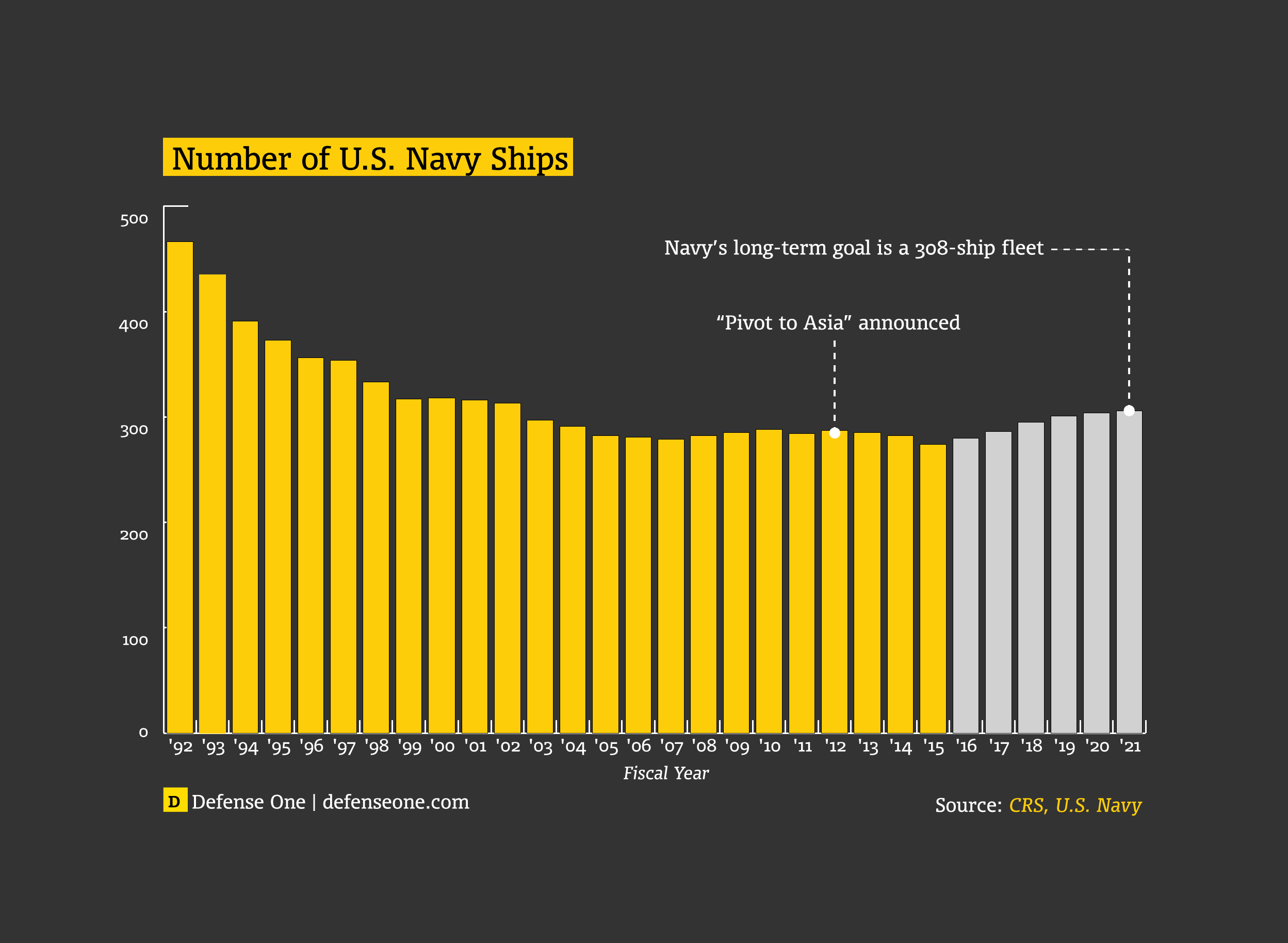
It’s not as if the Navy, and Mabus, weren’t already in the fight: aviators flying from the aircraft carrier USS Theodore Roosevelt pounded ISIS targets last year; the USS Harry S. Truman is currently on station doing the same. In Iraq, Syria, and across North Africa, Navy SEALs are filling many of the American boots on the ground.
But there’s a definite course change being laid in, thanks largely to a newly belligerent Russia and still-rising China. Writes Richardson: “For the first time in 25 years, the United States is facing a return to great power competition. Russia and China both have advanced their military capabilities to act as global powers.” If that sounds familiar, it’s because you’ve already heard it from Carter and Deputy Defense Secretary Bob Work, former undersecretary of the Navy.
At the Defense One Summit in November, Work said the U.S. can’t do everything anymore. Today, “almost all our combat power” is in the United States itself, he said, and “we think about swinging forces quickly from theater to theater.” Similarly, Richardson’s strategy document drops even his predecessor’s secondary emphasis on presence — the ubiquitous distribution of naval assets for show-the-flag and other operations — and concentrates on capacity, or the ability to bring war-winning power to bear on near-peer foes.
Watch for continuing pressure on Congress to begin coughing up billions
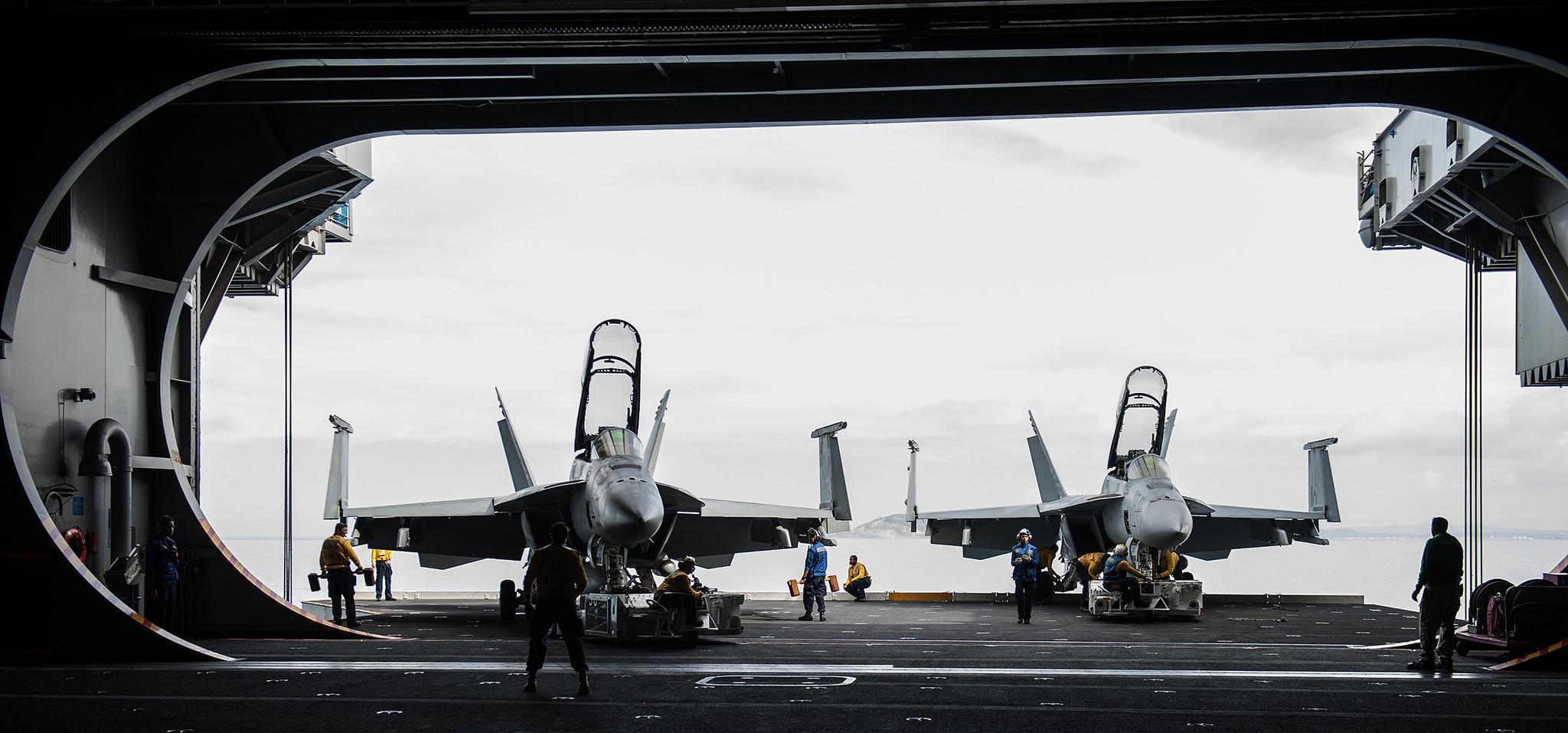

PACIFIC OCEAN (July 10, 2015) Sailors secure F/A-18F Super Hornets to an aircraft elevator aboard the aircraft carrier USS Ronald Reagan (CVN 76). (U.S. Navy photo by Mass Communication Specialist 3rd Class Nathan Burke)
Watch for continuing pressure on Congress to begin coughing up billions of dollars to replace the aging Ohio-class submarines whose ICBMs, untouchable in the deeps, remain the ultimate deterrent against other world powers. “This is foundational to our survival as a nation,” writes Richardson, a former chief of the Navy’s nuclear enterprise.
Finally, expect more of the crucial work being done to help the Navy attract and keep the best minds in a world of billion-dollar startups. If Carter has been disappointed with Mabus’ approach to equipping the Navy, he cannot quibble with the way naval leaders have embraced and extended his “Force of the Future” manpower initiatives — in particular, the Navy secretary’s early declaration that women should be allowed to try to qualify for any job in the naval services.
And with just a year left in the Obama administration — and in the tenures of Carter and Mabus alike — look for attempts to make these changes stick, no matter who comes next.
***
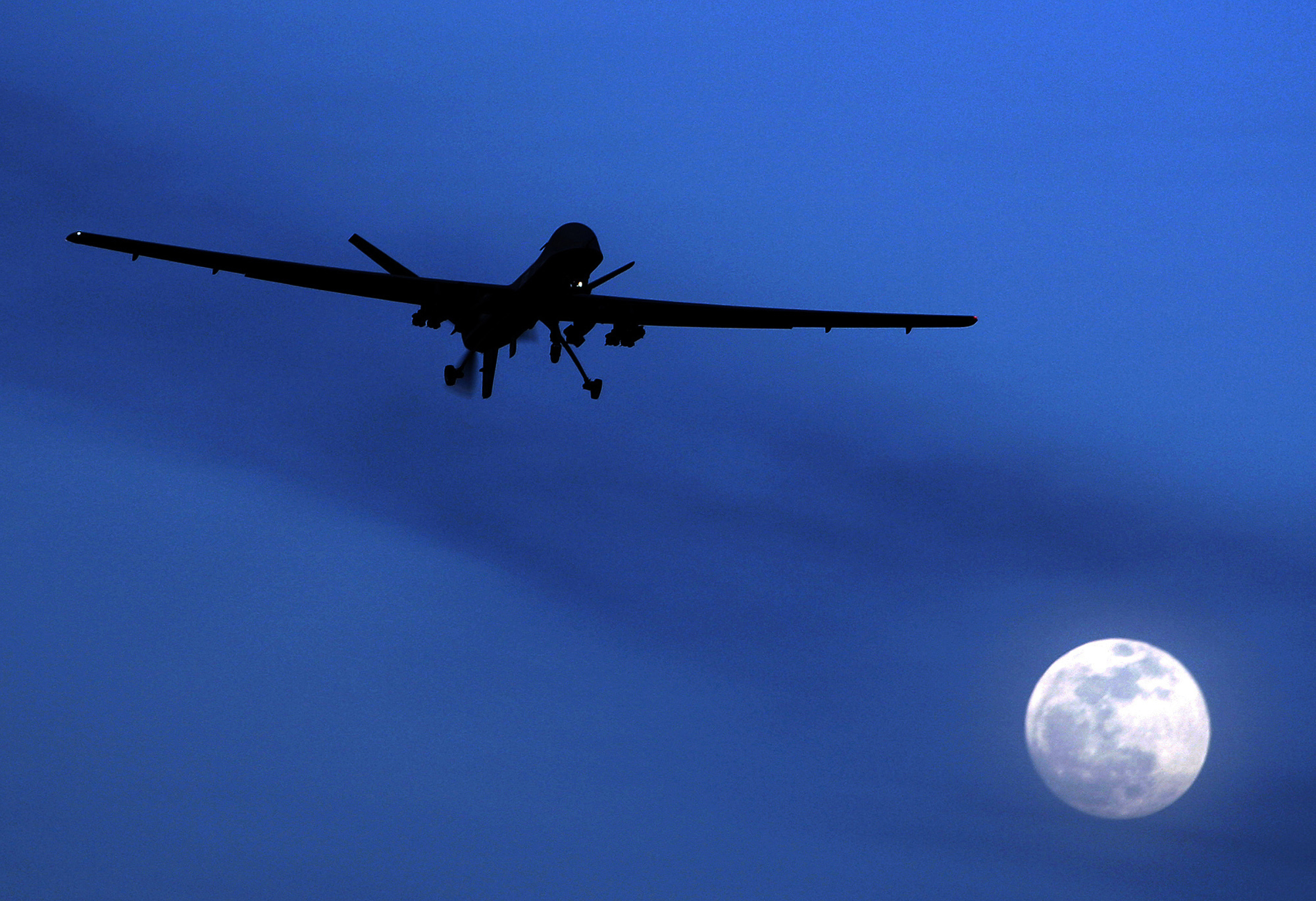

A smaller, older air service is working hard to gear up for the next fights.
After years of shrinking to pay the bills of the large-scale ground wars in Iraq and Afghanistan, the Air Force has too few people. That’s according to Deborah James, who has vowed to spend her final year as Air Force secretary turning that around.
“We need to stop the downsizing that we have been undergoing in the Air Force,” James said. “Instead, we need to upsize, modestly, and we need to do that in a total force way.” That means growing not only growing the active-duty ranks, but also in the Air National Guard and Reserve.
James says the Air Force needs more cyber warriors, nuclear-bomb tenders, and aircraft maintainers. “Everywhere I have visited, I have found undermanning in the maintenance area, and skill mismatches as well,” she said.

Air Force Secretary Deborah Lee James speaks about budget cuts, sexual assaults, and other issues facing the U.S. Air Force, Wednesday, Dec. 2, 2015, at the National Press Club in Washington. (AP Photo/Manuel Balce Ceneta)
On the hardware side, the Air Force is carrying out its largest aircraft overhaul in decades. As Gen. Mark Welsh, the Air Force chief of staff, put it last year: nearly a dozen of its aircraft fleets “qualify for antique license plates in the state of Virginia.”
But there’s been progress there over the past year, and more new planes are on the way. The Air Force is expected to declare the F-35 Joint Strike Fighter battle ready this summer. New refueling tankers, which will replace ones built under President Eisenhower, are starting to roll off Boeing’s assembly line. The Air Force recently inked a deal with Northrop Grumman to build a new stealth bomber. Also on tap are new search-and-rescue helicopters, intelligence planes, a new Air Force One, and jets to train student pilots.
And then there’s a new $3 billion plan to expand the drone program.
“[W]e’ve got to modernize,” James said.
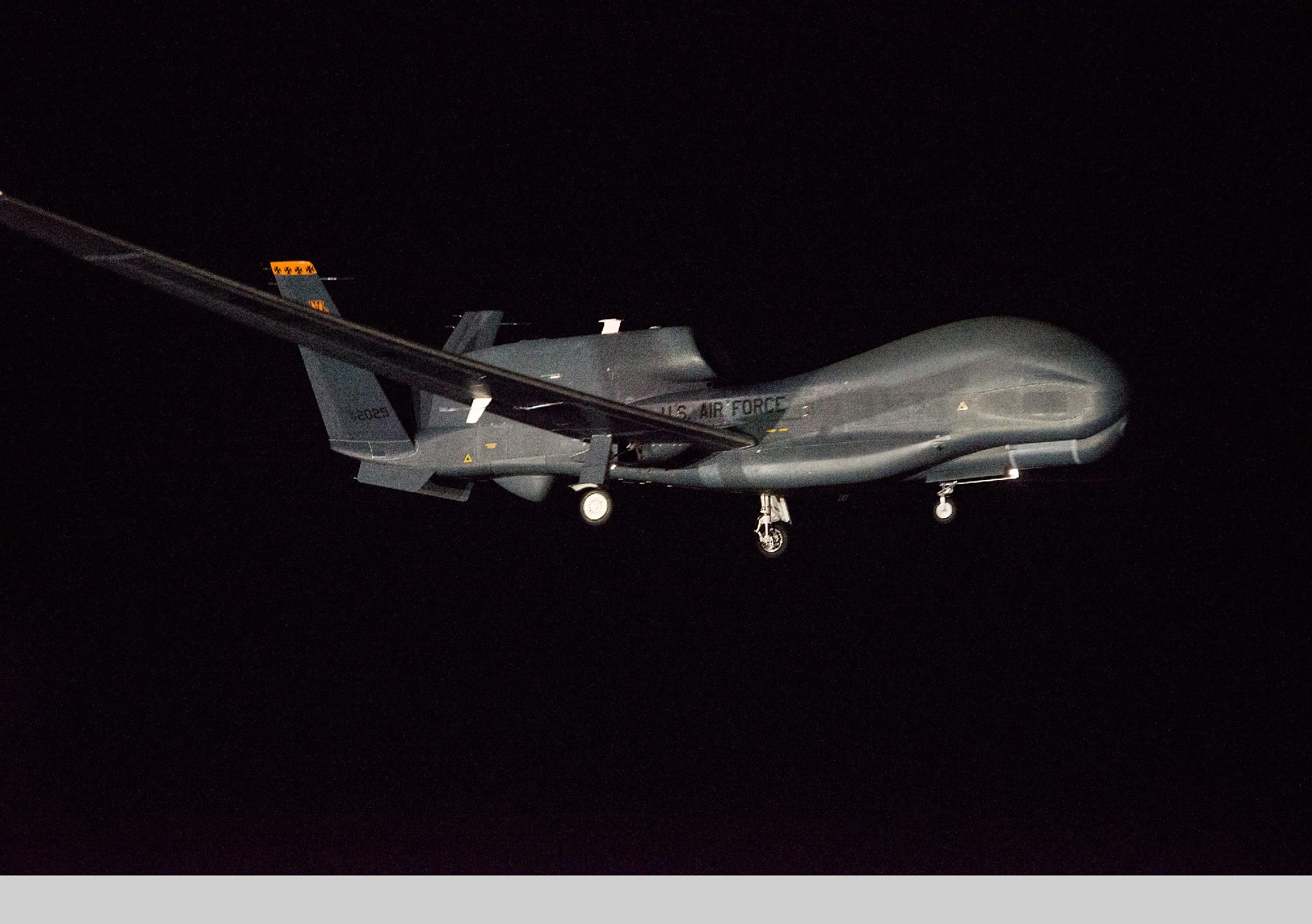

The Northrop Grumman RQ-4 Global Hawk (AP Photo)
But at a time when the entire military is feeling the budget pinch, will the Air Force be able to complete its ambitious overhaul? Caps on the Pentagon budget mean the service might have to buy fewer planes each year or delay purchases altogether.
“The need to replace several types of aircraft simultaneously poses challenges to future budgets, as the new programs compete with existing program commitments and normal program growth under a restricted service topline,” Congressional Research Service analyst Jeremiah Gertler wrote in a Dec. 17 report.
Beyond planes, Air Force officials say they also need to invest in new satellites, nuclear weapons infrastructure, cyber defenses, and other technology in order to ensure the U.S. military’s edge on the battlefield of the future.
Even with older warplanes, the Air Force has been at the forefront of the American-led bombing campaign against Islamic State militants.
But without more money in 2017, the planned new stuff will be sacrificed for more urgent needs: training and equipment for the current wars, and preserving the size of the air force. James promises to protect pay, family programs, and educational benefits for airmen: “Pay needs to continue to go up modestly, not go down or not remain steady.”
But, she says, “Those dollars had to be apportioned somehow and that will be real programs of some sort that are going to get cut,” James said.
The secretary has put a premium on readiness, or making sure troops at home station are always prepared to fight a battle. Air Force leaders are funding more flight hours for pilots and improving training ranges “so we can practice more against the types of high-end threats that we might face in the future,” James said.
Even with older warplanes, like the A-10 attack plane first flown in the 1970s, the Air Force has been at the forefront of the American-led bombing campaign against Islamic State militants in Iraq and Syria. Air Force planes, including the B-1B bomber, F-15, F-16, and F-22 fighters and drones, have flown consistently flown more than half of the combat missions.
The older equipment is performing well on the airstrike missions, but the length of the campaign will tell the final story, James said. Air Force leaders are now looking to replenish bomb stockpiles.


An A-10C Thunderbolt II sits under a sun shade July 29, 2014, at Moody Air Force Base, Ga. (U.S. Air Force photo/Airman 1st Class Ryan Callaghan)
The Air Force will also continue playing a large role in Europe. Like the rest of the U.S. military, the service has been sending more airmen and planes across the pond more frequently to train more often with NATO allies since Russia’s 2014 invasion of Ukraine.
“You’re going to continue to see robust, perhaps even more robust, rotational and exercise situation in Europe where we’re sending forces over there for periods of time to exercise and practice with our allies, which also have the effect of reassurance and deterrence,” James said.
But don’t expect new permanent positions in Europe, James said.
“My guess is you won’t see any substantial increase in the number of people permanently stationed in Europe over the next year or two,” she said.
But what you can expect in high-end warplanes, like stealthy F-22 Raptors, to continue making temporary deployments to the continent.
“We’re hopeful that it comes again here very soon,” said Lt. Gen. Timothy Ray, commander of 3rd Air Force and 17th Expeditionary Air Force, the arm of the service that provides airmen, arms and equipment to U.S. European and Africa Commands.
The five things that we do really, really well are what the combatant commanders need.
The F-22 represents the high end of Air Force weapons that have cycled through Europe of the past year. A mix of high- and and low-end equipment continue coming through the continent, but at “a pace better than it has been in the past,” Ray said.
“I don’t see a change in the importance that we are going to play in that whole region,” he said. “I do believe it’s a good time to start bringing more rotational forces from the states over.”
Within the past year, Ray’s forces conducted missions across a wide range of areas: gathering intelligence, bombing targets, moving troops and equipment, protecting airspace, and providing command and control.
“We’ll see that again this year and the year after,” he said.
Throw the Pentagon’s Pacific pivot, the desire to deploy more American forces to Asia, into the mix and that makes for a busy year ahead for the Air Force.
“We’re globally in demand and I think we’re going to remain that way for the foreseeable future because the five things that we do really, really well are what the combatant commanders need,” she said.
***


The Corps is caught between the big wars of the last decade and the counterterrorism efforts of today.
Folks, it looks like the Marines may have themselves an identity crisis. Again.
Many times in its history, the Marine Corps has had to justify its existence between the big Army formations on land and the Navy forces that carry its units to shore. After many years of fighting in the Hindu Kush mountains and northern Iraqi deserts, the past few commandants have pledged to Congress they want to return the Corps to its amphibious roots. You know, the old “we’re not a second land Army” line. That meant rebuilding the equipment and refocusing the training on storming beaches. But at the same time, the Marines, somewhat reluctantly, set up their own special forces branch to compete for and contribute to today’s smaller operations: killing enemies, training friends, and more quietly fighting America’s battles abroad.
To be sure, Marines are still in the conventional fight. Harriers from Bahrain are striking ISIS targets. Response forces are in and out of Africa. And Marines are part of the small group of advisors at al-Asad, the airbase that housed thousands of U.S. fighters during the Iraq War. But it’s not the same as the old days of Fallujah and Sangin.
This summer at Camp Pendleton, Defense Secretary Ash Carter told Marines they were amid a “great strategic transition” after Afghanistan and Iraq. “That said, that was then and now is now. And we can’t forget about [counterinsurgency], but we’re beginning to turn our sights to the full spectrum of threats and challenges that will characterize our strategic future. And the Marine Corps fits right squarely at the center of that.” Exactly how, Carter couldn’t say, only repeating that the U.S. would need the “flexibility” the Corps has always offered. And he talked about the need for more cyber warriors.
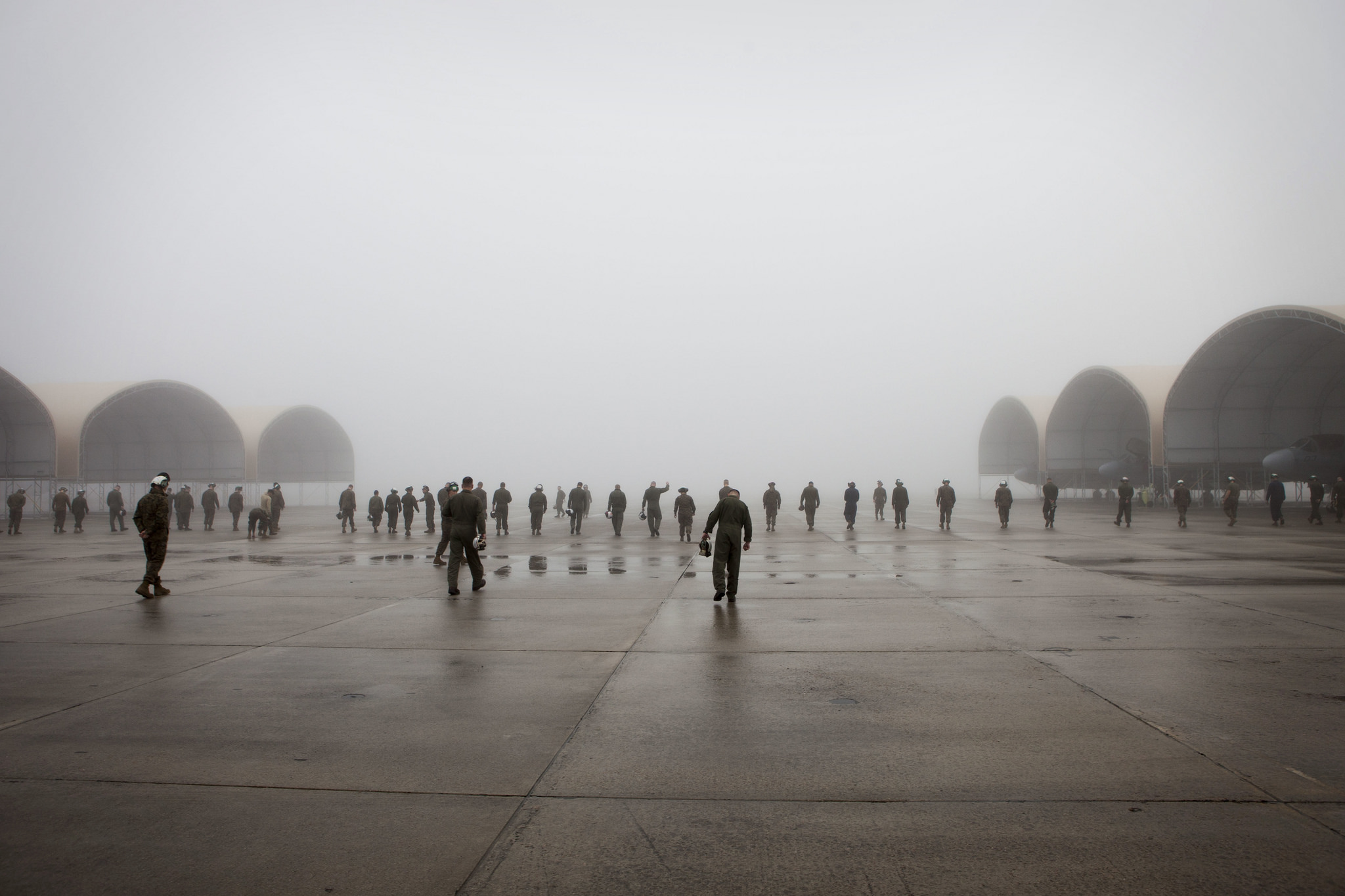

Marines assigned to Marine Tactical Electronic Warfare Squadron (VMAQ) 2, participate in a foreign object debris walk aboard Marine Corps Air Station Cherry Point, North Carolina, Dec. 2, 2015. (U.S. Marine Corps photo by Lance Cpl. Anthony J. Brosilow)
So now what, for 2016? There’s a new commandant, Gen. Robert Neller, who has said he will wait a year before issuing the customary “guidance” — a document many commanders anticipate that usually defines the way forward. For now, he’s on a talking-and-listening tour. But don't call it an identity crisis, his spokesman says.
“We don't see the time now as between wars for us. We have an identity,” said Lt. Col. Eric Dent. “While others may say, 'look at us, we're relevant!' we don't say that. We know we are. We are engaged in a day-to-day fight. For example: our cyber guys are literally at war right now.”
Dent said the Marines’ flexibility is inherent, they are integrated into everything the military does, from humanitarian assistance to combat, and they are working to better integrate into the special operations forces workflow. “Look for more on that in the coming month or so.”
But Marine Corps Times reports Neller has some “big changes” in store for 2016. Atop the list: physical fitness standards. Also: cracking down on alcohol abuse. Well, maybe not-so-big changes.
What has changed is that the Marines are not being called up in formation to pound the streets of Ramadi to expel ISIS. The Iraqis did that, while a small group of U.S. military advisors and special operators stayed mostly on the outskirts. It was Iraqis in the line of fire, not U.S. Marines, and that’s by design.
Neller has barely made a blip publicly. That’s also by design. But since September, he has been conducting a personal survey of the Corps, holding 48 “town halls” so far at bases around the globe. And what is he telling the troops? If called to take the ISIS capital of Raqqa, Syria, he said, the Marines certainly could do the job. But overall, he’s not too eager to have Marines fighting the ISIS war – especially if they’re expected to once again hold, patrol, and play security force in a hot region with no clear political path to peace.
“What’s next? Who do we give it to? I don’t want to stay in Raqqa. There’s nothing there that I want,” Neller told Marines in Okinawa in November.
The year does have a couple tangible changes on the horizon: opening combat jobs long closed to women, and a replacement (finally! maybe!) for the Marine’s iconic amphibious vehicle.
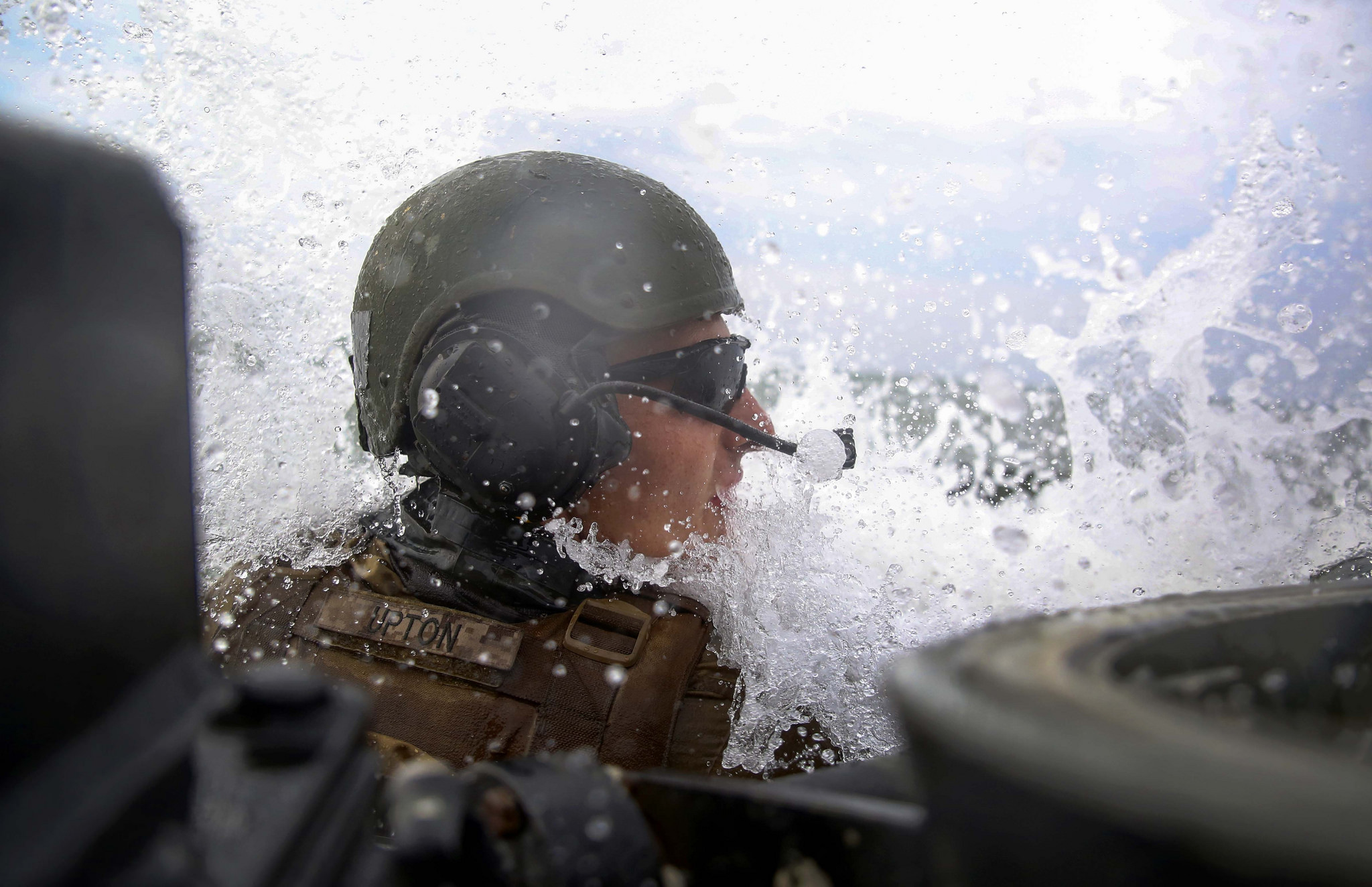

Lance Cpl. Garrick R. Upton, an Amphibious Assault Vehicle operator with 2nd Assault Amphibian Battalion, 2nd Marine Division, shouts a warning back to his crew as he splashes into the surf of the Atlantic Ocean. (U.S. Marine Corps photo taken by Lance Cpl. Alex W. Mitchell)
This week, the Marine Corps commandant has a deadline to present Navy Secretary Ray Mabus a plan to render boot camp and Officer Candidate School gender-neutral by April 1. The Corps, the only service to request that some jobs remain all-male, is under close watch to get it right and play ball. After Defense Secretary Ash Carter said the U.S. military must be a joint force with common standards, the commandant said Marines would snap smart and obey. But the culture and attitude of the Corps, from grunt to general, is as much a concern as the actual integration process. This is the year that Marine Corps leaders will prove whether they are serious about welcoming women to every rank, post, and position.
I don’t want to stay in Raqqa. There’s nothing there that I want.
With time to breathe after big wars, the Corps last year finally took a big step toward replacing their Vietnam-era fleet of beach-storming assault vehicles, or AAVs. To nobody’s shock, they asked two companies, BAE and SAIC, to produce 13 prototypes of what are now called amphibious combat vehicles, or ACVs, for the price of roughly $225 million. That’s $17 million per vehicle. (Each of the 17 Marines inside therefore gets a million-dollar lift, at least in the testing phase.) Eventually, the Corps wants the winning design to cost between $4 million and $7.5 million. It’s the second time the service has tried to buy a suitable replacement beach cruiser. Their first effort, dubbed the Expeditionary Fighting Vehicle program, expended $3 billion before collapsing five years ago.
There is some question about whether a replacement AAV is even needed. Former Defense Secretary Robert Gates says China’s defenses would prevent any such landing, whereupon the Marines responded with plenty of studies showing a need to maintain that ship-to-shore assault capability. The powers that be approved, and so the Marines will continue on after all, from Camp Pendleton to Iraq. Flexible, and ready.
The first prototypes are due this fall.
***
What do you think?
Let’s continue the conversation on Twitter at #StateofDefense.
And get the latest from Defense One delivered right to your inbox every morning by signing up for our daily newsletter.